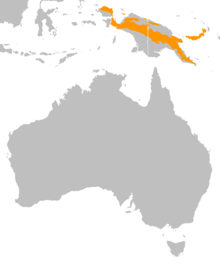Dwarf cassowary
| Dwarf cassowary | |
|---|---|
 |
|
| Scientific classification | |
| Kingdom: | Animalia |
| Phylum: | Chordata |
| Class: | Aves |
| Superorder: | Paleognathae |
| Order: | Casuariiformes |
| Family: | Casuariidae |
| Genus: | Casuarius |
| Species: | C. bennetti |
| Binomial name | |
|
Casuarius bennetti Gould, 1857 |
|
 |
|
| Distribution of the dwarf cassowary | |
| Synonyms | |
|
List
|
|
The dwarf cassowary (Casuarius bennetti) also known as the Bennett's cassowary, little cassowary, mountain cassowary, or mooruk, is the smallest of the three species of cassowaries.
The scientific name commemorates the Australian naturalist George Bennett. He was the first scientist to examine these birds after a few were brought to Australia aboard a ship. Recognising them as a new species of cassowary, he sent specimens back to England, where other taxonomists confirmed his perception. On the west side of Geelvink Bay, western Irian, there is a distinctive form that may merit a split. C. papuanus is the tentative name. There are no officially recognized sub-species, however, some authors believe there should be.
The Karam or Kalam people of the New Guinea Highlands classify bats and flying birds as one group, yaket, and the dwarf cassowary, a very large, wingless, flightless bird as another, kobtiy. Yaket are bony with wings and fly in the air, while kobtiy are bony without wings and are terrestrial and of the forest. They distinguish kobtiy from other bony, wingless animals because kobtiy are not quadrupedal like dogs and lizards and are not limbless like snakes. (See Kalam languages.)
John Gould first identified the dwarf cassowary from a specimen from New Britain, in 1857.
The dwarf cassowary is a large bird but is slightly smaller than other living cassowaries (the southern cassowary and northern cassowary). It is between 99 and 150 cm (3.25 and 4.92 ft) long and weighs between 17.6 and 26 kg (39 and 57 lb). It is a flightless bird with hard and stiff black plumage, a low triangular casque, pink cheek and red patches of skin on its blue neck. Compared to other cassowaries, the dwarf cassowary is shorter, with a tarsi length of 24.5 cm (9.6 in), with a slightly smaller bill, at 11 to 12.2 cm (4.3 to 4.8 in). The feet are large and powerful, equipped with dagger-like claws on the inner toe. Both sexes are similar. Females have longer casques, brighter bare skin color and are larger in size.
...
Wikipedia

